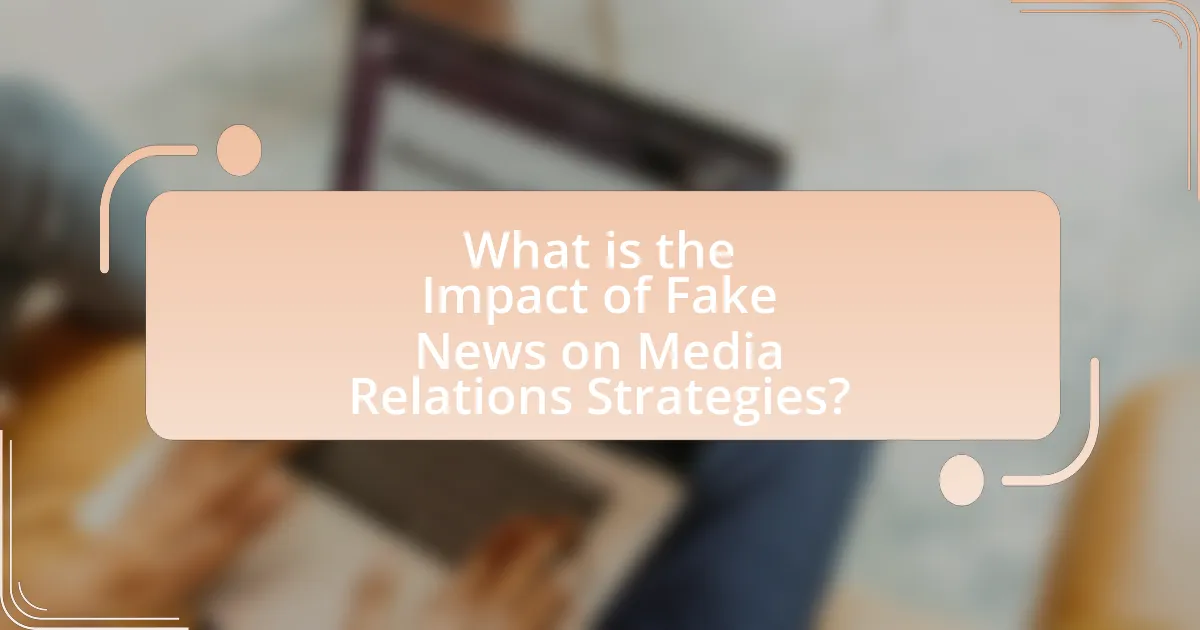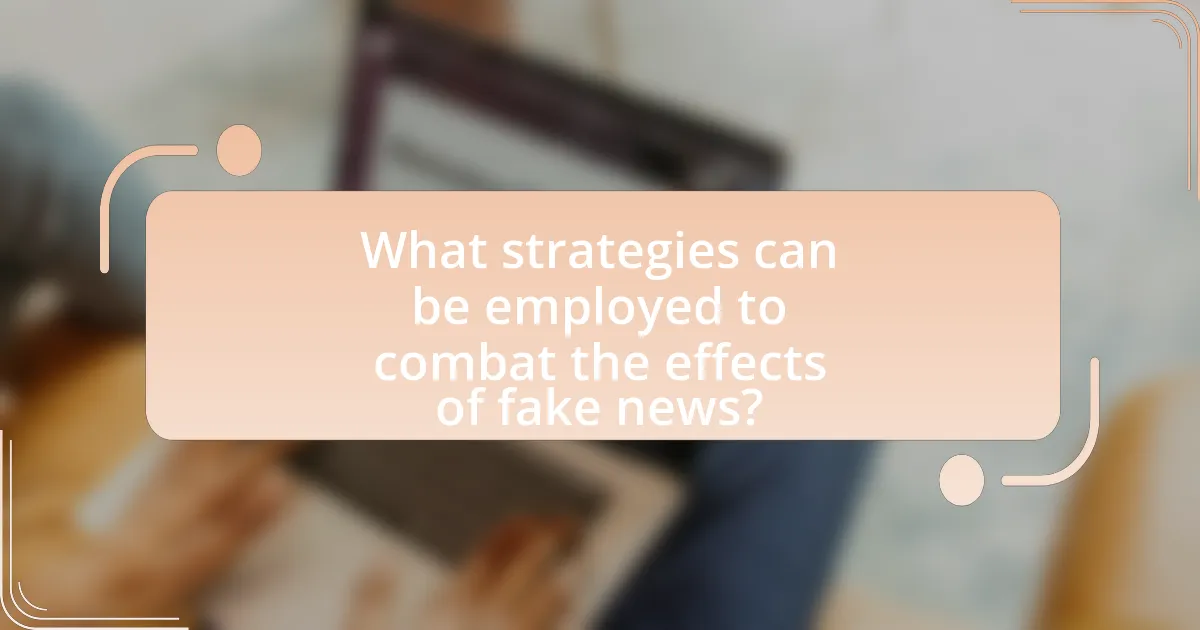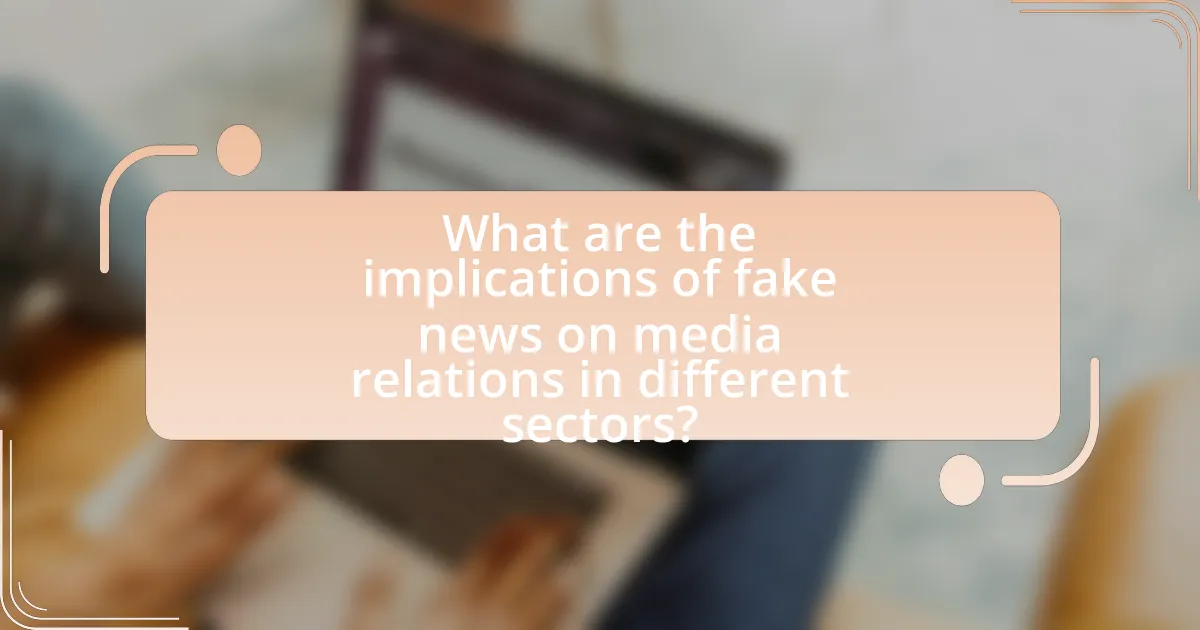The article examines the significant impact of fake news on media relations strategies, highlighting how misinformation erodes trust between organizations and their audiences. It discusses the necessity for media relations professionals to adopt proactive communication strategies, including transparency and rapid response mechanisms, to counteract false narratives. The article also explores the influence of fake news on public perception of media organizations, the importance of credibility, and the role of social media in disseminating misinformation. Additionally, it outlines best practices for combating fake news, such as fact-checking initiatives and media literacy programs, emphasizing the need for organizations to develop resilient media relations strategies in the face of ongoing challenges posed by misinformation.

What is the Impact of Fake News on Media Relations Strategies?
Fake news significantly undermines media relations strategies by eroding trust between organizations and their audiences. When false information circulates, it creates confusion and skepticism, making it challenging for media relations professionals to convey accurate messages. A study by the Pew Research Center found that 64% of Americans believe that fake news has caused a great deal of confusion about the basic facts of current events. This environment compels organizations to adopt more proactive communication strategies, including increased transparency and rapid response mechanisms to counter misinformation. Consequently, media relations strategies must now prioritize fact-checking and audience engagement to rebuild trust and credibility.
How does fake news influence public perception of media organizations?
Fake news significantly undermines public perception of media organizations by fostering distrust and skepticism. When individuals encounter false information attributed to reputable media outlets, they often generalize this distrust to all media, leading to a broader perception that media organizations are unreliable. A study by the Pew Research Center in 2020 found that 53% of Americans believe that news organizations intentionally mislead the public, a sentiment exacerbated by the prevalence of fake news. This erosion of trust can result in decreased audience engagement and a reluctance to consume news from traditional media sources, ultimately impacting the credibility and effectiveness of these organizations in communicating accurate information.
What role does credibility play in media relations amidst fake news?
Credibility is essential in media relations, especially in the context of fake news, as it directly influences public trust and the effectiveness of communication strategies. When media outlets and organizations maintain high credibility, they are better positioned to counteract misinformation and establish themselves as reliable sources of information. Research indicates that 85% of consumers are more likely to trust news from credible sources, which underscores the importance of credibility in fostering audience engagement and loyalty. Furthermore, organizations that prioritize transparency and fact-checking can mitigate the adverse effects of fake news, thereby enhancing their reputation and maintaining effective media relations.
How does fake news affect audience trust in traditional media?
Fake news significantly undermines audience trust in traditional media by creating skepticism about the accuracy and reliability of news sources. Research indicates that exposure to fake news leads to a decline in trust, as audiences struggle to differentiate between credible journalism and misinformation. A study by the Pew Research Center found that 64% of Americans believe that fabricated news stories cause confusion about the basic facts of current events, which directly impacts their perception of traditional media outlets. Consequently, as audiences increasingly question the integrity of news reporting, traditional media faces challenges in maintaining credibility and fostering trust among its viewers.
Why is understanding fake news crucial for media relations professionals?
Understanding fake news is crucial for media relations professionals because it directly affects their ability to communicate effectively and maintain credibility. Media relations professionals must recognize the prevalence of misinformation, as studies indicate that 64% of Americans believe that fake news causes confusion about basic facts. This understanding enables them to develop strategies to counteract false narratives, protect their organization’s reputation, and ensure accurate information reaches the public. By being aware of the tactics used in spreading fake news, such as sensationalism and emotional manipulation, media relations professionals can craft more effective messaging and engage with audiences in a way that builds trust and transparency.
What are the potential consequences of ignoring fake news in media strategies?
Ignoring fake news in media strategies can lead to significant misinformation, eroding public trust and damaging reputations. When media outlets fail to address or counteract false information, they risk amplifying its reach, which can mislead audiences and create confusion. A study by the Pew Research Center found that 64% of Americans believe that fabricated news stories cause a great deal of confusion about the basic facts of current events. This confusion can result in a polarized audience, where individuals become entrenched in their beliefs, further complicating effective communication strategies. Additionally, organizations that do not actively combat fake news may find themselves associated with false narratives, leading to reputational harm and loss of credibility.
How can media relations adapt to the challenges posed by fake news?
Media relations can adapt to the challenges posed by fake news by implementing proactive fact-checking and transparency measures. By establishing partnerships with fact-checking organizations, media relations can ensure that information disseminated is accurate and credible, thereby countering misinformation. For instance, the Poynter Institute’s research indicates that organizations that engage in regular fact-checking see a significant increase in audience trust. Additionally, media relations can enhance their communication strategies by utilizing social media platforms to directly address and correct false narratives, as evidenced by the success of various news outlets in debunking fake news stories in real-time. This approach not only mitigates the spread of misinformation but also reinforces the credibility of the media outlet.

What strategies can be employed to combat the effects of fake news?
To combat the effects of fake news, implementing media literacy education is essential. Media literacy programs equip individuals with critical thinking skills to analyze and evaluate information sources effectively. Research from the Stanford History Education Group indicates that students who received media literacy training were better at distinguishing credible sources from unreliable ones. Additionally, promoting fact-checking initiatives can help verify information before dissemination. Organizations like Snopes and FactCheck.org provide resources to debunk false claims, thereby reducing the spread of misinformation. Furthermore, fostering collaboration between social media platforms and fact-checkers can enhance the identification and labeling of fake news, as seen in Facebook’s partnership with third-party fact-checkers to reduce misinformation on its platform.
How can media relations professionals effectively respond to fake news?
Media relations professionals can effectively respond to fake news by promptly identifying misinformation and issuing clear, factual statements to counter it. This approach involves monitoring media channels and social media platforms for false narratives, which allows professionals to address inaccuracies swiftly. For instance, a study by the Pew Research Center found that 64% of Americans believe that fake news causes confusion about basic facts, highlighting the necessity for timely and accurate responses. By providing verified information and engaging with audiences directly, media relations professionals can mitigate the spread of false information and restore public trust.
What communication tactics can mitigate the spread of misinformation?
Effective communication tactics to mitigate the spread of misinformation include promoting media literacy, utilizing fact-checking resources, and fostering transparent communication. Media literacy education equips individuals with the skills to critically evaluate information sources, reducing susceptibility to false claims. Research indicates that individuals with higher media literacy are less likely to believe misinformation (Mihailidis & Viotty, 2017). Fact-checking resources, such as Snopes and FactCheck.org, provide verified information that can counter false narratives, thereby enhancing public trust in accurate reporting. Transparent communication from credible sources, including government agencies and reputable organizations, helps to clarify facts and dispel rumors, as evidenced by the World Health Organization’s effective communication during the COVID-19 pandemic, which significantly reduced misinformation about the virus.
How can transparency enhance media relations in the face of fake news?
Transparency can enhance media relations by fostering trust and credibility, which are essential in combating fake news. When organizations openly share information, including their sources and decision-making processes, they create an environment where journalists can verify facts easily. This openness allows media professionals to distinguish between credible information and misinformation, thereby reducing the spread of fake news. For instance, a study by the Pew Research Center found that 70% of Americans believe that transparency from organizations can help them better understand news stories, indicating that clear communication can mitigate the effects of misinformation.
What role does social media play in the dissemination of fake news?
Social media serves as a primary platform for the rapid dissemination of fake news, significantly amplifying its reach and impact. The architecture of social media allows for the swift sharing and viral spread of information, regardless of its accuracy. According to a study by the Massachusetts Institute of Technology, false news stories are 70% more likely to be retweeted than true stories, highlighting the platform’s role in propagating misinformation. Additionally, algorithms prioritize engaging content, often favoring sensational or misleading headlines, which further contributes to the spread of fake news. This dynamic creates an environment where misinformation can thrive, influencing public perception and media relations strategies.
How can media relations leverage social media to counteract fake news?
Media relations can leverage social media to counteract fake news by actively monitoring online conversations and promptly addressing misinformation. By utilizing tools like social listening platforms, media relations teams can identify false narratives and engage directly with audiences to provide accurate information. For instance, a study by the Pew Research Center found that 64% of Americans believe that social media has a significant role in spreading false information, highlighting the need for proactive communication strategies. Additionally, by collaborating with fact-checking organizations and sharing verified content through social media channels, media relations can enhance credibility and foster trust among the public.
What are the best practices for monitoring social media for fake news?
The best practices for monitoring social media for fake news include utilizing automated tools, verifying sources, and engaging with audiences. Automated tools like fact-checking software can quickly identify misinformation patterns, while verifying sources ensures that information comes from credible outlets. Engaging with audiences allows organizations to clarify misconceptions and provide accurate information directly. Research indicates that 59% of social media users encounter fake news, highlighting the necessity of these practices to maintain trust and credibility in media relations.

What are the implications of fake news on media relations in different sectors?
Fake news significantly undermines media relations across various sectors by eroding trust and credibility. In the healthcare sector, misinformation can lead to public health crises, as seen during the COVID-19 pandemic, where false information about treatments and vaccines spread rapidly, causing confusion and hesitancy among the public. In the political sector, fake news can distort electoral processes, influencing voter behavior and undermining democratic institutions, as evidenced by the 2016 U.S. presidential election, where false narratives circulated widely on social media. In the corporate sector, companies face reputational damage from false claims, leading to financial losses and strained relationships with stakeholders; for instance, a 2020 study found that 70% of consumers are less likely to trust a brand after exposure to fake news about it. Overall, the implications of fake news on media relations are profound, affecting trust, decision-making, and overall communication strategies across sectors.
How does fake news impact corporate media relations strategies?
Fake news significantly impacts corporate media relations strategies by necessitating more proactive communication and reputation management efforts. Corporations must adapt their media relations to counter misinformation, often leading to increased transparency and rapid response protocols. For instance, a study by the Pew Research Center found that 64% of Americans believe that fake news causes confusion about basic facts, prompting companies to enhance their fact-checking processes and engage directly with audiences through social media to clarify misinformation. This shift in strategy aims to build trust and maintain credibility in an environment where public perception can be easily swayed by false narratives.
What specific challenges do businesses face due to fake news?
Businesses face significant challenges due to fake news, primarily including reputational damage, loss of consumer trust, and financial implications. Reputational damage occurs when false information spreads, leading to negative perceptions among customers and stakeholders. For instance, a 2020 study by the Pew Research Center found that 64% of Americans believe that fake news has caused confusion about basic facts, which can directly impact a company’s image.
Loss of consumer trust is another critical challenge, as misinformation can lead customers to question the integrity of a business. According to a 2021 Edelman Trust Barometer, 61% of respondents stated that they would stop purchasing from a brand they perceived as dishonest.
Financial implications arise when businesses must invest in crisis management and public relations efforts to counteract the effects of fake news. A report from the Global Disinformation Index indicated that misinformation could cost brands up to $78 billion annually due to lost revenue and increased marketing costs. These challenges highlight the profound impact fake news can have on businesses, necessitating robust media relations strategies to mitigate risks.
How can companies build resilience against fake news in their media strategies?
Companies can build resilience against fake news in their media strategies by implementing proactive communication plans and fostering media literacy among their stakeholders. Proactive communication plans involve regularly updating audiences with accurate information and addressing misinformation swiftly, which can mitigate the spread of false narratives. For instance, a study by the Pew Research Center found that organizations that engage in transparent communication are more trusted by their audiences, thereby reducing the impact of fake news. Additionally, fostering media literacy equips employees and customers with the skills to critically evaluate information sources, which can further diminish the influence of fake news.
What lessons can be learned from case studies of fake news incidents?
Case studies of fake news incidents reveal critical lessons about the importance of media literacy and the need for robust fact-checking mechanisms. These incidents demonstrate that misinformation can rapidly spread through social media, leading to significant public confusion and damage to reputations. For instance, the 2016 U.S. presidential election highlighted how false narratives influenced voter perceptions and behaviors, emphasizing the necessity for organizations to proactively engage in transparent communication and educate their audiences on identifying credible sources. Furthermore, the response strategies employed during these incidents, such as timely corrections and public engagement, illustrate that swift action can mitigate the negative impacts of fake news.
What successful strategies have been implemented to counter fake news?
Successful strategies implemented to counter fake news include fact-checking initiatives, media literacy programs, and collaboration between technology platforms and news organizations. Fact-checking initiatives, such as those by Snopes and PolitiFact, provide verified information to debunk false claims, significantly reducing the spread of misinformation. Media literacy programs educate the public on identifying credible sources and understanding the nature of news, which has been shown to improve critical thinking skills regarding information consumption. Additionally, collaborations between technology platforms like Facebook and news organizations aim to flag and reduce the visibility of false information, as evidenced by Facebook’s partnership with third-party fact-checkers to assess the accuracy of content shared on its platform. These strategies collectively enhance public awareness and promote a more informed society.
How can these lessons inform future media relations practices?
Lessons from the impact of fake news can inform future media relations practices by emphasizing the need for transparency and proactive communication. Organizations must prioritize building trust with their audiences by providing accurate information and addressing misinformation swiftly. For instance, a study by the Pew Research Center found that 64% of Americans believe that fake news has caused a great deal of confusion about the basic facts of current events, highlighting the necessity for media relations strategies that counteract misinformation effectively. By implementing fact-checking protocols and engaging directly with audiences through social media, organizations can enhance their credibility and mitigate the effects of fake news on public perception.
What are the best practices for media relations in the age of fake news?
The best practices for media relations in the age of fake news include establishing transparency, building trust, and actively engaging with the audience. Transparency involves providing clear and accurate information to counter misinformation, as seen in organizations that openly share their sources and methodologies. Building trust can be achieved through consistent communication and by being responsive to inquiries, which fosters credibility. Actively engaging with the audience through social media platforms allows organizations to address concerns and correct false narratives in real-time, as demonstrated by news outlets that utilize these channels to clarify their reporting. These practices are essential for maintaining a positive relationship with the media and the public amidst the challenges posed by fake news.
How can organizations develop a proactive media relations strategy?
Organizations can develop a proactive media relations strategy by establishing clear communication goals and building strong relationships with journalists. This involves identifying key media outlets and influencers relevant to the organization’s industry, creating a media list, and regularly engaging with these contacts through personalized outreach. Additionally, organizations should prepare press materials, such as press releases and media kits, that provide accurate and timely information, helping to counteract misinformation. Research indicates that organizations with proactive media strategies are better equipped to manage their reputations, as they can respond swiftly to emerging narratives, thereby reducing the impact of fake news. For instance, a study by the Pew Research Center found that 62% of journalists prefer to receive information directly from organizations, highlighting the importance of direct communication in shaping media narratives.
What tools and resources are available to help combat fake news?
Tools and resources available to help combat fake news include fact-checking websites, media literacy programs, and browser extensions. Fact-checking websites like Snopes and FactCheck.org provide verified information to debunk false claims. Media literacy programs educate individuals on how to critically evaluate sources and discern credible information from misinformation. Browser extensions such as NewsGuard and Media Bias/Fact Check help users identify the reliability of news sources in real-time. These resources collectively empower individuals to recognize and challenge fake news effectively.